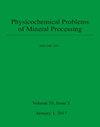Semi-quantitative analysis study of the impact of microwave treatment on fly ash
IF 1.3
4区 工程技术
Q4 CHEMISTRY, PHYSICAL
引用次数: 0
Abstract
Pre-processing provides an effective way for fly ash's high value-added utilization. However, the shortcomings of pre-processing methods such as grinding and flotation are apparent, with many disadvantages that make it more challenging to use efficiently. Microwave heating helps the SiO2-Al2O3 bond break, not only can make the structural change of the material can also promote the chemical reaction process. In the article, XRD, SEM, FT-TR, ammonia nitrogen adsorption, and other methods were used to analyze the changes in the properties of fly ash before and after microwave pre-treatment, the change of adsorption performance of fly ash before and after microwave treatment was analyzed. The study found that under microwave conditions of 600W and 15min, the adsorption rate of ammonia nitrogen by fly ash reached the maximum of 29.67%. The intensity of mullite and amorphous diffraction peaks decreased after 20 minutes at 600W. The Si-O-(Si, Al) and Si-O-(Si) bonds showed significant changes at 15 and 20 minutes under 600W conditions. Based on the results, microwave conditions were selected at 600W for different periods, and semi-quantitative analysis was carried out by XRD-Rietveld, infrared peak fitting, and nuclear magnetic resonance. The XRD-Rietveld analysis showed that the amorphous phase content reached 46.18% at 15 minutes. In the infrared peak fitting, the fitting area at 1300-900cm-1 and 600-400cm-1 peaks reaches 56.92% at 25 minutes and 17.5% at 15 minutes, respectively. The silicon-oxygen network's degree of connection and polymerization is reduced after 15 minutes of microwave treatment for the nuclear magnetic resonance analysis.微波处理对粉煤灰影响的半定量分析研究
预处理为粉煤灰的高附加值利用提供了有效途径。然而,诸如磨矿和浮选等预处理方法的缺点是显而易见的,它们的许多缺点使其更难以有效利用。微波加热有助于SiO2-Al2O3键断裂,不仅能使材料的结构发生变化还能促进化学反应过程。本文采用XRD、SEM、FT-TR、氨氮吸附等方法分析了微波预处理前后粉煤灰性能的变化,分析了微波预处理前后粉煤灰吸附性能的变化。研究发现,在600W、15min的微波条件下,粉煤灰对氨氮的吸附率最高可达29.67%。在600W下加热20 min后,莫来石和非晶态衍射峰强度减小。在600W条件下,Si- o -(Si, Al)和Si- o -(Si)键在15和20分钟时发生了显著变化。在此基础上,选择600W不同时段的微波条件,通过XRD-Rietveld、红外峰拟合、核磁共振进行半定量分析。XRD-Rietveld分析表明,在15分钟时,非晶相含量达到46.18%。在红外峰拟合中,1300-900cm-1和600-400cm-1峰的拟合面积在25分钟达到56.92%,在15分钟达到17.5%。经过15分钟的微波处理进行核磁共振分析后,硅氧网络的连接和聚合程度降低。
本文章由计算机程序翻译,如有差异,请以英文原文为准。
求助全文
约1分钟内获得全文
求助全文
来源期刊

Physicochemical Problems of Mineral Processing
CHEMISTRY, PHYSICAL-MINING & MINERAL PROCESSING
自引率
6.70%
发文量
99
期刊介绍:
Physicochemical Problems of Mineral Processing is an international, open access journal which covers theoretical approaches and their practical applications in all aspects of mineral processing and extractive metallurgy.
Criteria for publication in the Physicochemical Problems of Mineral Processing journal are novelty, quality and current interest. Manuscripts which only make routine use of minor extensions to well established methodologies are not appropriate for the journal.
Topics of interest
Analytical techniques and applied mineralogy
Computer applications
Comminution, classification and sorting
Froth flotation
Solid-liquid separation
Gravity concentration
Magnetic and electric separation
Hydro and biohydrometallurgy
Extractive metallurgy
Recycling and mineral wastes
Environmental aspects of mineral processing
and other mineral processing related subjects.
 求助内容:
求助内容: 应助结果提醒方式:
应助结果提醒方式:


